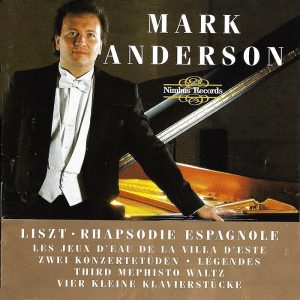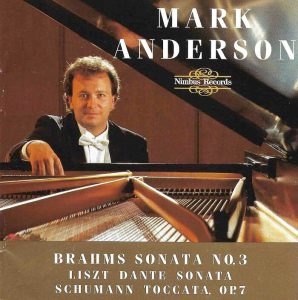Author: Kurth, Richard
Publication details: Annual Meeting of the American Musicological Society. Baltimore
Writing, Voice, and Illusion: Schumann’s Heine Song Am leuchtenden Sommermorgen
Liszt: Rhapsodie Espagnole
Artists: Mark Anderson
Recording details:
“As his two previous Nimbus discs (3/95 and 7/95 – the latter including a fine performance of Liszt’s Dante Sonata) show, Mark Anderson is a most musicianly pianist. His communicative ardour understandably made him an audience favourite at the 1993 Leeds Piano Competition and here, in this richly diverse programme, he again proves himself a born orator, declaiming Liszt’s fantasy and nobility in generous-hearted fashion. At the same time all these performances (with the exception of the curiously elliptical and prophetic Vier kleine Klavierstücke which are played with a rapt concentration and intensity) have an off-the-cuff flavour with the spirit often engulfing the letter of the score”- Gramophone
Nimbus Records, 1996
Dis-regarding Schoenberg’s Twelve-Tone Rows: An Alternative Approach to Listening and Analysis for Twelve-Tone Music
Author: Kurth, Richard
Publication details: Theory and Practice 21: 79-122
Weblink: www.jstor.org
Geisha, Kouta, and Karaoke
Author: Hesselink, Nathan
Publication details: Kyoto Journal 32:18-23 (1996)
Changdan Revisited: Korean Rhythmic Patterns in Theory and Contemporary Performance Practice
Author: Hesselink, Nathan
Publication details: Han’guk ŭmak yŏn’gu [Studies in Korean Music] 24:143-55 (1996)
Weblink: www.dbpia.co.kr
Music and Poetry: A Wilderness of Mirrors
Author: Kurth, Richard
Publication details: Interdisciplinary 19th Century Studies Colloquium Series, Green College, UBC, Vancouver
A Calculus of Accent
Author: Roeder, John
Publication details: Journal of Music Theory 39, no. 1 (Spring, 1995): 1-46
Weblink: http://www.jstor.org
Abstract: Writings by Wallace Berry and William Benjamin describe musical accent not simply as the momentary emphasis of a time-point in relation to its context, but as the “the intensity peak of a shaped pattern of activity,” and “a point from which reactive events recede and toward which preparatory events incline.” It follows that our perception of the weight of an accent-which bears crucially on analysis-depends both upon its musical context and upon what moment we are at in the piece. This paper formalizes the concept of accents of climax in a model of musical streams related formally to the constructs of Tenney and Lewin. The algebraic definition of accent in this model does not correspond to traditional notions of pitch or durational accent, but it precisely captures the “peaking” process that Berry and Benjamin discuss. It specifies the weight of an accent within a given musical stream, and quantifies how our evaluation of an accent varies over time. The discrete version of the theory is applied to excerpts from works by Berio, Carter, Bartók, and Schoenberg. It reveals patterns of increasing or decreasing weight which establish a direction, or progression, independent of “a priori” pitch-structural functions. It also uncovers similarities of accentual pattern which help to associate different timepoints in a composition, that is, to create musical form. The algebraic expressions of the theory generalize naturally using the differential calculus to describe the formation of accent when pitch, dynamics, or other musical properties are changing continuously, as in some electroacoustic music. This continuous version of the theory is applied in analyses of Xenakis’s “Diamorphoses II” and Carter’s Woodwind Etude No. 7.
Using Topologies to Survey Pitch-Class Spaces
Author: Kurth, Richard
Publication details: West Coast Conference of Music Theory and Analysis. University of British Columbia, Vancouver
Brahms: Piano Sonata No. 3
Artists: Mark Anderson
Recording details:
“Mark Anderson here proves himself a musician-pianist to the manner born. From the powerful opening surge of the Brahms Sonata to the closing chord of the Schumann Toccata, his authority and pianistic command are never in doubt. A debut recital disc of impressive quality. Performance, Five Stars!” – Classic CD
Nimbus Records, 1995
Schoenberg’s Notes on Coherence: Theory or Prolegomena to the Twelve-Tone Method?
Author: Kurth, Richard
Publication details: Theory and Practice 20: 177-192
Weblink: www.jstor.org

